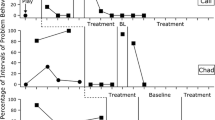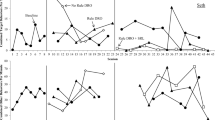Abstract
In the present examination of a self-reinforcement procedure, self-delivery of reinforcers and self-monitoring were manipulated separately while social reinforcement was held constant. The subjects were developmentally disabled men employed as cafeteria workers in two supported work enclaves. In a compound alternating treatment and multiple baseline design, three workers were trained to reliably self-monitor and self-reinforce their on-task behavior every 30 minutes at the sound of a timer beep. In a second treatment phase, they self-monitored but did not self-reinforce. Response contingent praise and a reinforcement contingency for accurately self-monitoring were programmed during both treatment phases. Self-monitoring with self-reinforcement produced an increase in level of on-task behavior for all three workers, which decreased when self-reinforcement was discontinued. Order of treatment phases was reversed for four additional workers. For three of these workers, level of on-task behavior was higher when they self-reinforced. These results indicate that self-reinforcement exerts behavioral control beyond that attributable to self-monitoring and concomitant social reinforcement.
Similar content being viewed by others
References
AGRAN, M., FODOR-DAVIS, J., MOORE, S., & DEER, M. (1989). The application of a self-management program on instruction following skills. Journal of the Association for Persons with Severe Handicaps, 14, 147–154.
ALBION, F., & SALZBERG, C. (1982). The effect of self-instructions on the rate of correct addition problems with mentally retarded persons. Education and Treatment of Children, 5, 212–231.
BANDURA, A. (1977a). Self-efficacy: Toward a unifying theory of behavioral change. Psychological Review, 84, 191–215.
BANDURA, A. (1977b). Social learning theory. New Jersey: Prentice-Hall.
BANDURA, A. (1978). A self-system in reciprocal determinism. American Psychologist, 33, 344–358.
BANDURA, A. (1981). Self-referent thought: A developmental analysis of self-efficacy. In J. H. Flavell & I. Ross (Eds.), Social cognitive development. Cambridge, England: Cambridge University Press.
BELLAMY, G. T. (1975). Habilitation of the severely and profoundly retarded: A review of research on work productivity. In T. Bellamy (Ed.), Habilitation of severely and profoundly retarded adults: Reports from the specialized training program. Eugene, OR: University of Oregon Center on Human Development.
BOLSTAD, O. D., & JOHNSON, S. M. (1972). Self-regulation in the modification of disruptive classroom behavior. Journal of Applied Behavior Analysis, 5, 443–454.
BOX, G. E. P., & JENKINS, G. M. (1976). Time-series analysis: Forecasting and control. San Francisco: Holden-Day.
BURGIO, L. D., WHITMAN, T. L., & JOHNSON, M. L. (1980). A self-instructional package for increasing attending behavior in educable retarded children. Journal of Applied Behavior Analysis, 13, 443–459.
CATANIA, A. C. (1975). The myth of self-reinforcement. Behaviorism, 3, 192–199.
COOK, T. D., & CAMPBELL, D. T. (1979). Quasi-experimentation. Boston: Houghton Mifflin.
DRABMAN, R. S., SPITALNICK, R., & O’LEARY, K. D. (1973). Teaching self-control to disruptive children. Journal of Abnormal Psychology, 82, 10–16.
GLYNN, E. L. (1970). Classroom applications of self-determined reinforcement. Journal of Applied Behavior Analysis, 3, 122–132.
GOLDIAMOND, I. (1976). Self-reinforcement. Journal of Applied Behavior Analysis, 9, 509–514.
HAYES, S. A., ROSENFARB, I., WULFERT, E., MUNT, E. D., KORN, Z., & ZETTLE, R. D. (1985). Self-reinforcement effects: An artifact of social standard setting? Journal of Applied Behavior Analysis, 18, 201–214.
HERRNSTEIN, R. J., (1970). On the law of effect. Journal of the Experimental Analysis of Behavior, 13, 243–266.
HUGHES, C., & PETERSON, D. L. (1989). Utilizing a self-instructional training package to increase on-task behavior and work performance. Education and Training of the Mentally Retarded, 16, 114–120.
KAROLY, P. (1982). Perspectives on self-management and behavior change. In P. Karoly & F. H. Kanfer (Eds.), Self-management and behavior change. New York: Pergamon Press.
KAZDIN, A. E. (1982). Single case research designs. New York: Oxford University Press.
LOVITT, T. C., & CURTISS, K. A. (1969). Academic response rate as a function of teacher and self-imposed contingencies. Journal of Applied Behavior Analysis, 2, 49–53.
MAHONEY, M. J., & BANDURA, A. (1972). Self-reinforcement in pigeons. Learning and Motivation, 3, 293–303.
MCNALLY, R. J., KOMPIK, J. J., & SHERMAN, G. (1984). Increasing the productivity of mentally retarded workers through self-management. Analysis and Intervention in Developmental Disabilities, 4, 129–135.
NELSON, R. D., HAYES, S. C., SPONG, R. T., JARRETT, R. B., & MCKNIGHT, D. L. (1983). Self-reinforcement: Appealing misnomer or appealing mechanism. Behavior Research and Therapy 21, 557–566.
NINNES, H. A. C., FUERST, J., RUTHERFORD, R. D., & GLENN, S. S. (1991). Effects of self-management training and reinforcement on the transfer of improved conduct in the absence of supervision. Journal of Applied Behavior Analysis, 24, 499–508.
OTTENBACHER, K. J. (1986). Evaluating clinical change. Baltimore: Williams and Wilkins.
PFADT, A., COHEN, I. L., SUDHALTER, V., ROMANCZYK, R. G., & WHEELER, D. J. (1992). Applying statistical process control to clinical data: An illustration. Journal of Applied Behavior Analysis, 24, 551–560.
SANSON-FISHER, R. W., POOLE, A. D., & DUNN, J. (1980). An empirical method for determining an appropriate interval length for recording behavior. Journal of Applied Behavior Analysis, 13, 493–500.
SOWERS, J. A., VERDI, M., BOURBEAU, P., & SHEEHAN, M. (1985). Teaching job independence and flexibility to mentally retarded students through the use of a self-control package. Journal of Applied Behavior Analysis, 18, 81–85.
THORESEN, C. E., & WILBUR, C. S. (1976). Some encouraging thoughts about self-reinforcement. Journal of Applied Behavior Analysis, 9, 518–520.
TRYON, W. W. (1982). A simplified time-series analysis for evaluating treatment interventions. Journal of Applied Behavior Analysis, 15, 423–429.
Author information
Authors and Affiliations
Rights and permissions
About this article
Cite this article
Kaplan, H., Hemmes, N.S., Motz, P. et al. Self-Reinforcement and Persons with Developmental Disabilities. Psychol Rec 46, 161–178 (1996). https://doi.org/10.1007/BF03395169
Published:
Issue Date:
DOI: https://doi.org/10.1007/BF03395169




